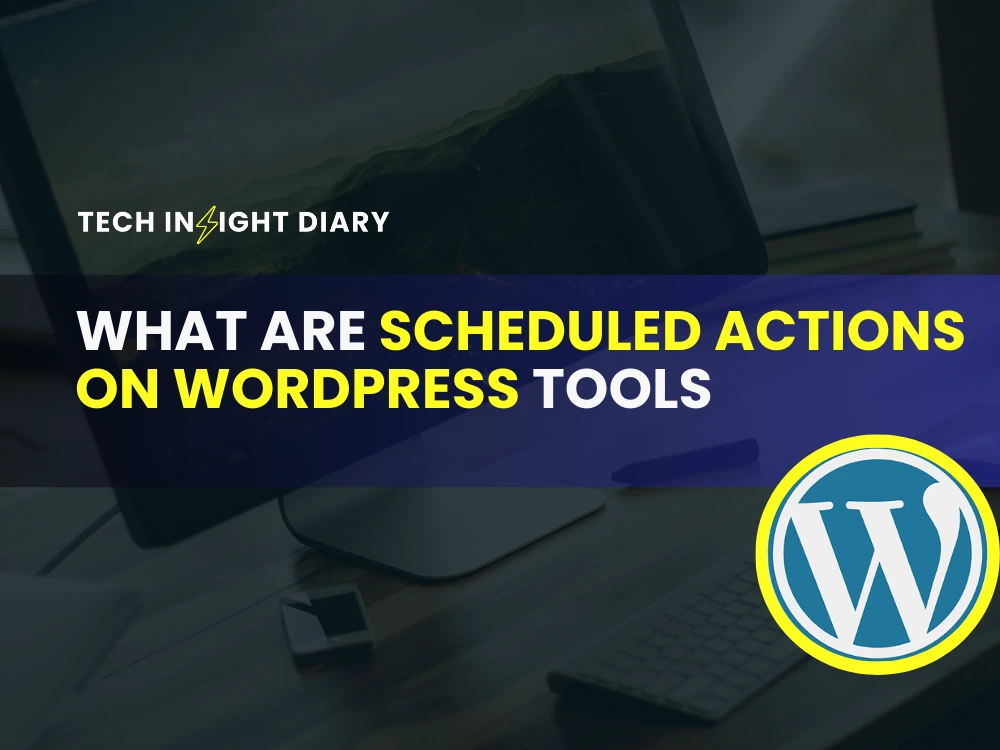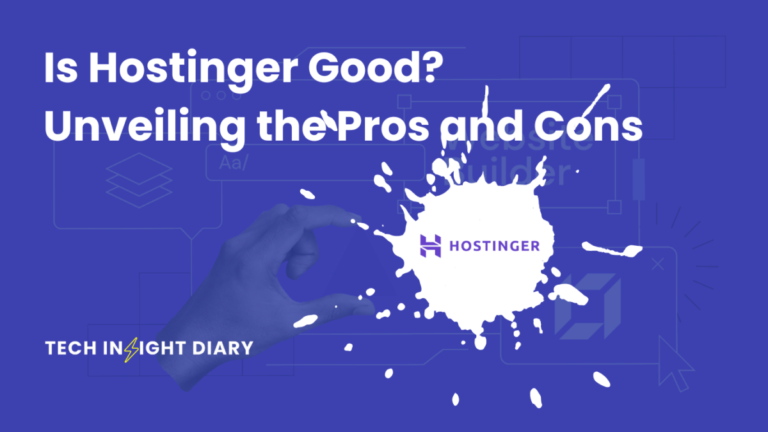Scheduled Actions on WordPress Tools allow users to automate tasks. These tasks can include publishing posts or running maintenance scripts.
WordPress Scheduled Actions are essential for automating repetitive tasks. They help streamline website management by setting specific times for actions like publishing posts, updating plugins, or running maintenance scripts. This feature saves time, increases efficiency, and ensures consistency. Users can schedule backups, email notifications, and even social media posts.
By leveraging Scheduled Actions, website administrators can focus on content creation and other crucial tasks. This automation tool is invaluable for maintaining an organized and smoothly running WordPress site. Whether you’re a blogger or a business owner, using Scheduled Actions can significantly enhance your website’s performance and user experience.
Scheduled Actions In WordPress
WordPress offers powerful tools to manage and automate various tasks. One such tool is Scheduled Actions. Scheduled Actions in WordPress allow users to automate tasks on a specific timetable. This feature ensures that you can manage your website efficiently without constant manual intervention.
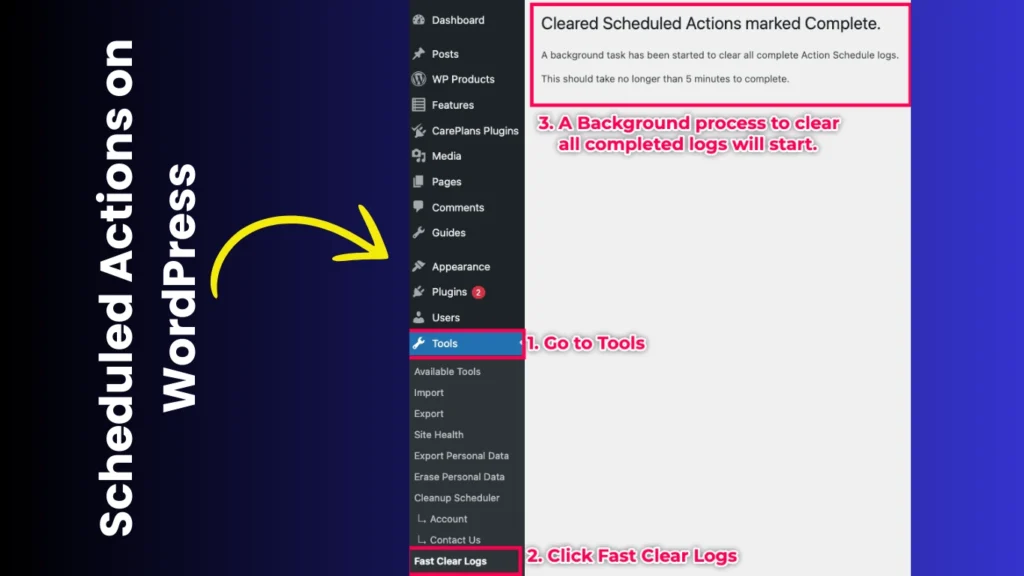
Purpose Of Scheduled Actions
Scheduled Actions in WordPress serve several important purposes. They help in automating repetitive tasks, ensuring your website runs smoothly. Here are some key purposes:
- Automation: Scheduled Actions automate routine tasks, saving time and effort.
- Consistency: These actions ensure tasks are performed consistently without human error.
- Efficiency: By automating tasks, you can focus on more strategic activities.
- Timely Updates: Scheduled Actions can keep your content fresh by automating updates.
For example, you can schedule blog posts, database backups, and plugin updates. This ensures your website remains up-to-date without manual intervention. Below is a table summarizing the key purposes:
| Purpose | Description |
|---|---|
| Automation | Automates routine tasks |
| Consistency | Ensures consistent task execution |
| Efficiency | Focus on strategic activities |
| Timely Updates | Keeps content fresh |
INFO: How to View HTML Code of WordPress Theme Saasland: Expert Guide
Common Use Cases
Scheduled Actions in WordPress have several common use cases. These use cases help you understand how to leverage this powerful tool:
- Publishing Blog Posts: You can schedule blog posts to go live at a specific time. This ensures regular content updates.
- Database Backups: Regular backups are crucial. Scheduled Actions can automate this task, ensuring data safety.
- Plugin and Theme Updates: Keeping plugins and themes updated is vital for security. Scheduled Actions can automate these updates.
- Sending Newsletters: You can schedule newsletters to be sent at a specific time, ensuring timely communication with your audience.
Below is a table summarizing these common use cases:
| Use Case | Description |
|---|---|
| Publishing Blog Posts | Schedule posts to go live at specific times |
| Database Backups | Automate regular backups for data safety |
| Plugin and Theme Updates | Automate updates for security |
| Sending Newsletters | Schedule newsletters for timely communication |
By understanding these common use cases, you can better utilize Scheduled Actions in WordPress to enhance your website’s efficiency and performance.
How Scheduled Actions Work
Scheduled Actions in WordPress are tasks set to run at specific times or intervals. Understanding how these actions work can help you automate routine tasks, improve site performance, and ensure timely updates. This section dives into how scheduled actions operate, starting with an overview of cron jobs and moving on to execution triggers.
Cron Jobs Explained
Cron jobs are automated tasks scheduled to run at specific intervals. These are essential for maintaining your WordPress site. With cron jobs, you can automate backups, updates, and other repetitive tasks. WordPress uses its own system called WP-Cron to manage these jobs.
WP-Cron doesn’t run constantly. Instead, it checks for scheduled tasks when someone visits your site. This ensures that tasks only run when your site has traffic, conserving server resources. Here are some common uses for cron jobs in WordPress:
- Database Backups: Regularly back up your database to prevent data loss.
- Plugin Updates: Automate plugin updates to keep your site secure.
- Content Publishing: Schedule posts to go live at specific times.
WP-Cron can be configured to run more efficiently. For example, you can set it to run at fixed intervals using a real cron job on your server. This is especially useful for high-traffic sites.
| Task | Frequency |
|---|---|
| Database Backup | Daily |
| Plugin Updates | Weekly |
| Content Publishing | As Scheduled |
Execution Triggers
Execution triggers are events that initiate scheduled actions. These can be time-based or event-based. In WordPress, triggers are essential for automating tasks without manual intervention. There are two main types of triggers:
- Time-Based Triggers: These run tasks at specific times or intervals. For example, you can schedule a backup to run every night at midnight.
- Event-Based Triggers: These run tasks in response to specific events. For example, you can trigger an action when a new post is published.
Time-based triggers rely on WP-Cron. They check the scheduled time and run tasks accordingly. Event-based triggers depend on specific actions within WordPress, like user registration or post publication. Both types of triggers help automate and streamline your workflow.
Here’s a table illustrating common execution triggers:
| Trigger Type | Example Task |
|---|---|
| Time-Based | Daily Backups |
| Event-Based | Send Email on New User Registration |
Understanding execution triggers can help you automate routine tasks. This leads to a more efficient and smooth-running WordPress site.
INFO: How to Know When a Form was Submitted WordPress: Easy Guide
Setting Up Scheduled Actions
Scheduled Actions in WordPress Tools allow users to automate repetitive tasks. Setting up scheduled actions can save time, improve efficiency, and ensure consistency. Whether you use plugins or configure them manually, setting up scheduled actions can help streamline your WordPress site.
Using Plugins
Using plugins is the easiest way to set up scheduled actions in WordPress. Plugins offer user-friendly interfaces and pre-built functionalities. This approach requires minimal technical knowledge. Here are some popular plugins for scheduled actions:
- WP Crontrol: Allows you to view and control what’s happening in the WP-Cron system.
- Advanced Cron Manager: Offers an advanced interface for managing scheduled actions.
- WP Scheduled Posts: Automates the scheduling of posts and other content.
Follow these steps to set up scheduled actions using plugins:
- Install and activate the plugin: Go to the Plugins section in your WordPress dashboard, search for the plugin, and click “Install Now”. Then, activate it.
- Configure settings: Navigate to the plugin settings. Each plugin will have different options. Customize the settings as per your needs.
- Schedule actions: Use the plugin interface to set up your scheduled tasks. For example, you can schedule a post, clear cache, or run database cleanups.
Plugins provide a hassle-free way to manage scheduled actions. They offer features that simplify the process and ensure tasks run smoothly.
Manual Configuration
Manual configuration of scheduled actions requires some coding skills. This approach provides greater flexibility and control over your tasks. Follow these steps to manually set up scheduled actions:
- Access functions.php: Open your theme’s
functions.phpfile. You can find this file in your theme directory. - Add custom code: Insert the following code to create a custom scheduled action:
function my_custom_cron_schedule($schedules) { $schedules['every_three_hours'] = array( 'interval' => 10800, 'display' => __('Every Three Hours') ); return $schedules; } add_filter('cron_schedules', 'my_custom_cron_schedule'); function my_custom_cron_job() { // Your custom code here } add_action('my_custom_cron_hook', 'my_custom_cron_job'); if (!wp_next_scheduled('my_custom_cron_hook')) { wp_schedule_event(time(), 'every_three_hours', 'my_custom_cron_hook'); } - Save and upload: Save your changes and upload the modified
functions.phpfile back to your server. - Verify scheduled actions: Check your WordPress dashboard to ensure your scheduled actions are running as expected. You can use the WP Crontrol plugin to view and manage these actions.
Manual configuration offers more customization options. It enables you to tailor scheduled actions to your specific requirements.
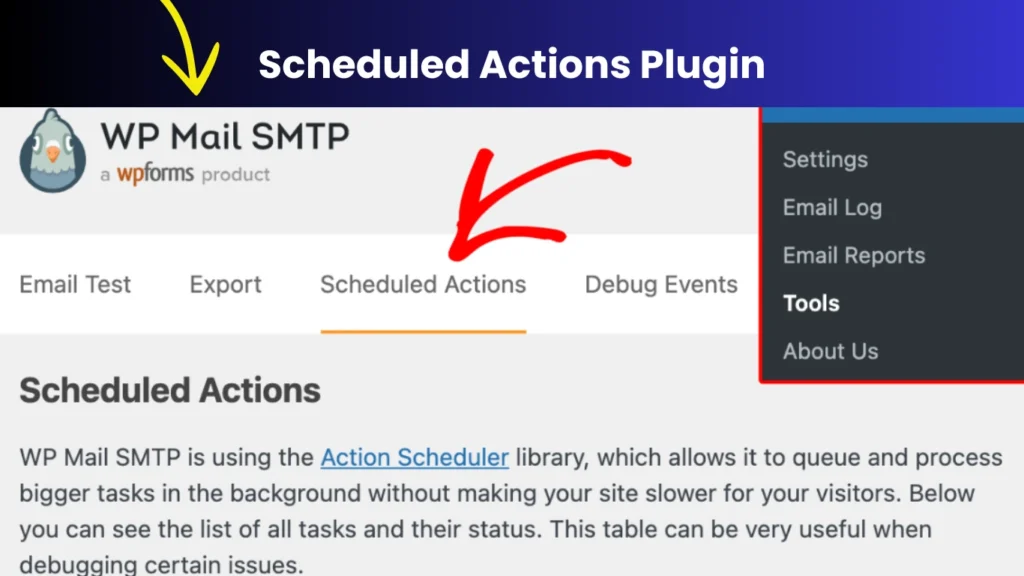
Managing Scheduled Actions
WordPress offers a powerful feature known as Scheduled Actions. These actions automate tasks, making your website run smoothly. Managing these actions ensures your site functions seamlessly. Understanding how to view, edit, and delete these actions is crucial for site maintenance.
Viewing Scheduled Actions
To view scheduled actions, navigate to the Tools menu in your WordPress dashboard. Select Scheduled Actions to see a list of all upcoming tasks. This list helps you monitor what’s set to happen on your site.
The Scheduled Actions screen displays various columns:
- Hook: The event trigger for the action.
- Arguments: Parameters passed to the action.
- Scheduled Date: When the action will occur.
- Recurrence: How often the action repeats, if applicable.
- Status: The current state of the action (Pending, Completed, etc.).
A table format can also be beneficial:
| Hook | Arguments | Scheduled Date | Recurrence | Status |
|---|---|---|---|---|
| publish_post | Post ID: 123 | 2023-10-10 10:00 AM | None | Pending |
| backup_database | None | 2023-10-12 02:00 AM | Daily | Completed |
This display allows you to keep track of all tasks efficiently.
Editing And Deleting Actions
Editing and deleting scheduled actions is essential for maintaining site health. To edit an action, click on the Edit link next to the action. You’ll be able to change parameters like the scheduled date, arguments, and recurrence.
For example, you might need to change a post’s publishing date:
Hook: publish_post
Arguments: Post ID: 123
Scheduled Date: 2023-10-12 12:00 PM
Recurrence: None
Status: Pending
Deleting an action is straightforward. Click on the Delete link next to the action. This removes the task from the schedule, ensuring it doesn’t execute. Always double-check before deleting to avoid missing critical tasks.
Steps to delete an action:
- Navigate to Tools > Scheduled Actions.
- Find the action you want to remove.
- Click the Delete link.
- Confirm the deletion.
Managing these actions ensures your site remains efficient and error-free. Regularly check and update scheduled actions for optimal performance.
Troubleshooting Issues
Scheduled Actions on WordPress Tools are crucial for automating tasks like publishing posts, sending emails, and updating plugins. But, sometimes things don’t go as planned. Troubleshooting issues can be challenging, but knowing common problems and their solutions can save time and frustration.
Common Problems
Scheduled Actions can sometimes fail due to various reasons. Here are some common problems you might encounter:
- Missed Schedules: Tasks do not execute at the scheduled time.
- Conflicts with Plugins: Some plugins may interfere with the scheduling system.
- Server Issues: Slow or unresponsive servers can delay scheduled tasks.
- Database Errors: Corrupted or outdated database entries can cause issues.
- Incorrect Timezone Settings: Mismatched timezones can lead to scheduling errors.
Understanding these common problems can help in diagnosing issues quickly. Often, these issues stem from underlying server settings or conflicts with other tools and plugins. Monitoring logs and error messages is also essential.
Solutions And Fixes
Addressing these issues requires a systematic approach. Here are some practical solutions:
- Check Timezone Settings: Ensure your WordPress timezone matches your server’s timezone. Go to Settings > General to verify.
- Update Plugins: Outdated plugins can cause conflicts. Regularly update all plugins to their latest versions.
- Disable Conflicting Plugins: Temporarily disable plugins to identify conflicts. Reactivate them one by one to find the culprit.
- Optimize Server Performance: Consider upgrading your hosting plan if your server is slow. Use caching and optimization plugins to improve performance.
- Check for Database Errors: Use tools like WP-DBManager to repair and optimize your database.
Implementing these solutions can resolve most scheduling issues. Regular maintenance and monitoring are key to preventing future problems. By keeping your site optimized and up-to-date, you ensure smooth operation of all scheduled actions.
INFO: How Does Tradelle Work: Unveiling the Secrets to Success
Best Practices
Scheduled Actions on WordPress Tools are automated tasks that run at specific times or intervals. These tasks can range from publishing posts to updating plugins. Following best practices ensures these actions run smoothly and efficiently, enhancing your site’s performance and reliability.
Optimization Tips
Optimizing scheduled actions can significantly improve your WordPress site’s performance. Here are some tips to follow:
- Limit the number of tasks: Too many scheduled actions can slow down your site. Identify essential tasks and eliminate unnecessary ones.
- Schedule during low-traffic periods: Run resource-intensive tasks during off-peak hours to reduce the impact on user experience.
- Use a caching plugin: Caching can reduce server load, making it easier to handle scheduled tasks.
- Monitor task duration: Use tools like WP Crontrol to monitor and manage the execution time of your tasks.
Here’s a simple example of how to schedule a task using code:
function my_custom_cron_job() { // Your custom code here } if ( ! wp_next_scheduled( 'my_custom_cron_job' ) ) { wp_schedule_event( time(), 'daily', 'my_custom_cron_job' ); } add_action( 'my_custom_cron_job', 'my_custom_cron_job' );
Use this table to understand the impact of different tasks:
| Task | Impact |
|---|---|
| Database Backup | High |
| Post Scheduling | Low |
| Plugin Updates | Medium |
Avoiding Conflicts
Avoiding conflicts is crucial for the smooth operation of scheduled actions. Here are some strategies to ensure conflict-free scheduling:
- Avoid overlapping tasks: Ensure that tasks do not overlap to prevent conflicts and resource contention.
- Regularly update plugins and themes: Outdated plugins can cause conflicts with scheduled actions.
- Use a staging environment: Test scheduled actions in a staging environment before deploying them to your live site.
- Monitor error logs: Regularly check your error logs to identify and resolve conflicts early.
Here’s a code snippet to avoid conflicts:
function my_custom_cron_job() { if ( ! wp_next_scheduled( 'my_custom_cron_job' ) ) { wp_schedule_event( time(), 'hourly', 'my_custom_cron_job' ); } } add_action( 'wp', 'my_custom_cron_job' );
Use this table to identify common conflict sources:
| Conflict Source | Resolution |
|---|---|
| Plugin Incompatibility | Update or replace the plugin |
| Theme Issues | Switch to a compatible theme |
| Server Limitations | Upgrade server resources |
Following these best practices ensures your scheduled actions run smoothly, maintaining your site’s performance and reliability.
Tools For Scheduled Actions
Scheduled actions in WordPress allow users to automate tasks such as posting content, updating plugins, or sending emails. These tools are essential for managing a website efficiently. They help save time and ensure that tasks are completed on time. There are various tools available for handling scheduled actions in WordPress, each offering different features and functionalities.
INFO: What is Tradelle: Unveiling the Ultimate Trading Platform
Popular Plugins
Several popular plugins can help manage scheduled actions in WordPress. These plugins offer a range of features to automate tasks and improve efficiency.
- WP Crontrol: This plugin allows you to view and control what’s happening in the WP-Cron system. You can add, edit, and delete cron events.
- Advanced Cron Manager: This plugin provides a simple interface to manage WP Cron events. It offers functionalities to add, edit, and delete scheduled tasks.
- AutomateWoo: A powerful plugin for WooCommerce stores. It helps automate marketing tasks, such as sending emails and offering discounts based on user actions.
- PublishPress Future (formerly known as Post Expirator): This plugin allows you to set an expiration date for posts. It helps manage content by automatically changing the status of posts after a certain period.
Using these plugins, you can significantly improve your workflow. They help you focus on more important tasks by automating repetitive actions. Each plugin offers unique features, making it easier to choose one that fits your needs.
Built-in WordPress Features
WordPress also includes built-in features for handling scheduled actions. These features are designed to automate basic tasks without requiring additional plugins.
- WP-Cron: WP-Cron is a built-in system for managing scheduled tasks in WordPress. It works by running tasks whenever a page is loaded, ensuring that scheduled actions are completed on time.
- Scheduled Posts: WordPress allows you to schedule posts to be published at a later date. This feature is useful for planning content ahead of time.
- Automatic Updates: WordPress can automatically update themes and plugins. This feature ensures that your site remains secure and up-to-date.
- Scheduled Backups: Some hosting providers offer built-in scheduled backups. This feature helps protect your site by creating regular backups.
These built-in features are easy to use and do not require additional setup. They help streamline your workflow and ensure that important tasks are completed on time. Using these features, you can maintain a well-organized and efficient website.
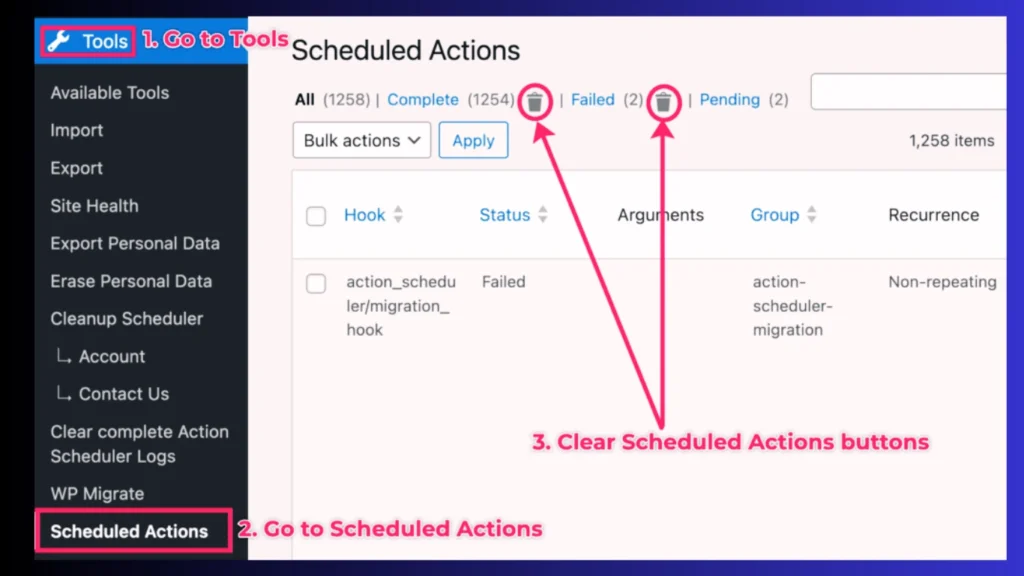
Future Of Scheduled Actions
Scheduled Actions in WordPress Tools are essential for automating tasks. They help manage routine activities, ensuring your site runs smoothly. As we look at the future of Scheduled Actions, we see exciting developments and improvements that will enhance their functionality and ease of use.
Upcoming Features
The future of Scheduled Actions in WordPress is bright. Developers are working on several new features to make them more robust and user-friendly. Here are some key upcoming features:
- Enhanced User Interface: A more intuitive and streamlined interface will make it easier for users to schedule and manage actions.
- Better Error Handling: Improved error reporting and handling will help users quickly identify and fix issues.
- Advanced Scheduling Options: Users will have more control over scheduling with options for complex recurrence patterns.
These features aim to provide more flexibility and reliability. A more intuitive UI will help beginners and experts alike. Better error handling will reduce downtime and improve site performance.
| Feature | Benefit |
|---|---|
| Enhanced User Interface | Ease of use for all users |
| Better Error Handling | Quick issue resolution |
| Advanced Scheduling Options | More control over tasks |
INFO: How to Make My Website Template WordPress: Step-by-Step Guide
Impact On WordPress Development
The improvements in Scheduled Actions will significantly impact WordPress development. Developers will benefit from these enhancements in several ways:
- Increased Efficiency: Automated tasks will save time, allowing developers to focus on more complex issues.
- Reduced Errors: Better error handling will minimize downtime and improve site reliability.
- Scalability: Advanced scheduling options will support larger and more complex websites.
These changes will make WordPress a more powerful platform. Increased efficiency means developers can complete projects faster. Reduced errors will lead to happier clients and users. Scalability will attract larger businesses to use WordPress.
- Efficiency: More time for creative tasks
- Reliability: Improved site performance
- Scalability: Support for growing businesses
The future of Scheduled Actions in WordPress looks promising. These developments will benefit users and developers alike, making WordPress a go-to platform for website management and development.
Frequently Asked Questions
What Are Scheduled Actions In WordPress?
Scheduled Actions are tasks automatically executed by WordPress at specified times or intervals, such as publishing posts or running updates.
How To View Scheduled Actions?
Navigate to Tools > Scheduled Actions in your WordPress dashboard to see all upcoming tasks and their details.
Can Scheduled Actions Improve Site Performance?
Yes, properly managing Scheduled Actions ensures your site runs tasks efficiently, improving overall performance and user experience.
How To Fix Failed Scheduled Actions?
Check your site’s cron jobs, plugin conflicts, or server issues. Use plugins like WP Crontrol to manage and troubleshoot tasks.
Conclusion
Mastering scheduled actions on WordPress tools can greatly enhance your website’s efficiency. Automating tasks saves time and reduces manual errors. Implement these features to streamline your workflow. Stay ahead by utilizing these powerful tools. Your website will benefit from improved performance and management.
Happy scheduling!

